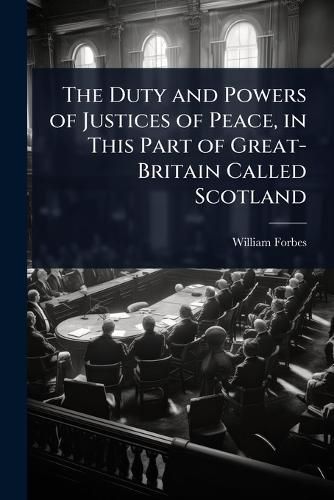Readings Newsletter
Become a Readings Member to make your shopping experience even easier.
Sign in or sign up for free!
You’re not far away from qualifying for FREE standard shipping within Australia
You’ve qualified for FREE standard shipping within Australia
The cart is loading…






This title is printed to order. This book may have been self-published. If so, we cannot guarantee the quality of the content. In the main most books will have gone through the editing process however some may not. We therefore suggest that you be aware of this before ordering this book. If in doubt check either the author or publisher’s details as we are unable to accept any returns unless they are faulty. Please contact us if you have any questions.
a??The Duty and Powers of Justices of Peace, in This Part of Great-Britain Called Scotlanda?? by William Forbes, is a comprehensive guide to the roles and responsibilities of justices of the peace in early 18th-century Scotland. This detailed treatise outlines the legal duties, authorities, and operational procedures relevant to magistrates during a formative period in British history following the Act of Union. The volume also includes an appendix providing essential reference material concerning weights and measures, offering valuable insight into the standardization efforts of the time. This historical legal text provides invaluable context for understanding the administration of law and order in Scotland and the broader legal framework of Great Britain. It is a crucial resource for legal historians, scholars of Scottish history, and anyone interested in the development of British legal institutions.
This work has been selected by scholars as being culturally important, and is part of the knowledge base of civilization as we know it. This work was reproduced from the original artifact, and remains as true to the original work as possible. Therefore, you will see the original copyright references, library stamps (as most of these works have been housed in our most important libraries around the world), and other notations in the work.
This work is in the public domain in the United States of America, and possibly other nations. Within the United States, you may freely copy and distribute this work, as no entity (individual or corporate) has a copyright on the body of the work.
As a reproduction of a historical artifact, this work may contain missing or blurred pages, poor pictures, errant marks, etc. Scholars believe, and we concur, that this work is important enough to be preserved, reproduced, and made generally available to the public. We appreciate your support of the preservation process, and thank you for being an important part of keeping this knowledge alive and relevant.
$9.00 standard shipping within Australia
FREE standard shipping within Australia for orders over $100.00
Express & International shipping calculated at checkout
Stock availability can be subject to change without notice. We recommend calling the shop or contacting our online team to check availability of low stock items. Please see our Shopping Online page for more details.
This title is printed to order. This book may have been self-published. If so, we cannot guarantee the quality of the content. In the main most books will have gone through the editing process however some may not. We therefore suggest that you be aware of this before ordering this book. If in doubt check either the author or publisher’s details as we are unable to accept any returns unless they are faulty. Please contact us if you have any questions.
a??The Duty and Powers of Justices of Peace, in This Part of Great-Britain Called Scotlanda?? by William Forbes, is a comprehensive guide to the roles and responsibilities of justices of the peace in early 18th-century Scotland. This detailed treatise outlines the legal duties, authorities, and operational procedures relevant to magistrates during a formative period in British history following the Act of Union. The volume also includes an appendix providing essential reference material concerning weights and measures, offering valuable insight into the standardization efforts of the time. This historical legal text provides invaluable context for understanding the administration of law and order in Scotland and the broader legal framework of Great Britain. It is a crucial resource for legal historians, scholars of Scottish history, and anyone interested in the development of British legal institutions.
This work has been selected by scholars as being culturally important, and is part of the knowledge base of civilization as we know it. This work was reproduced from the original artifact, and remains as true to the original work as possible. Therefore, you will see the original copyright references, library stamps (as most of these works have been housed in our most important libraries around the world), and other notations in the work.
This work is in the public domain in the United States of America, and possibly other nations. Within the United States, you may freely copy and distribute this work, as no entity (individual or corporate) has a copyright on the body of the work.
As a reproduction of a historical artifact, this work may contain missing or blurred pages, poor pictures, errant marks, etc. Scholars believe, and we concur, that this work is important enough to be preserved, reproduced, and made generally available to the public. We appreciate your support of the preservation process, and thank you for being an important part of keeping this knowledge alive and relevant.